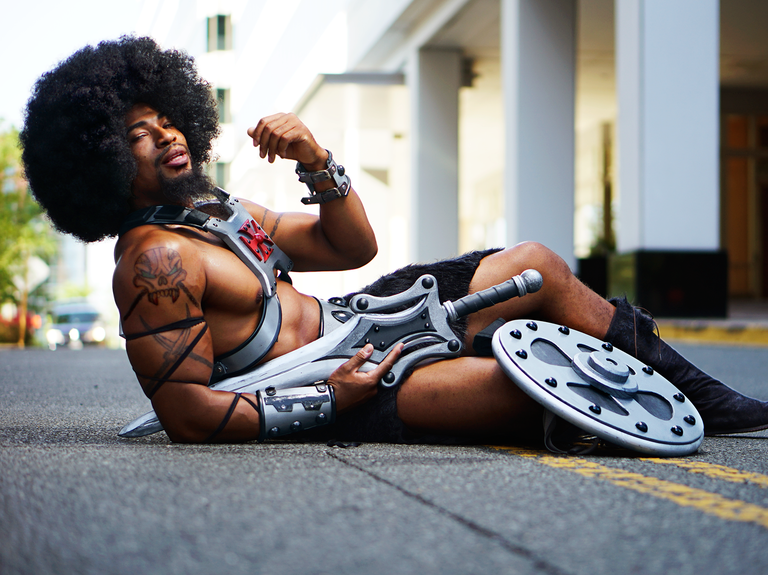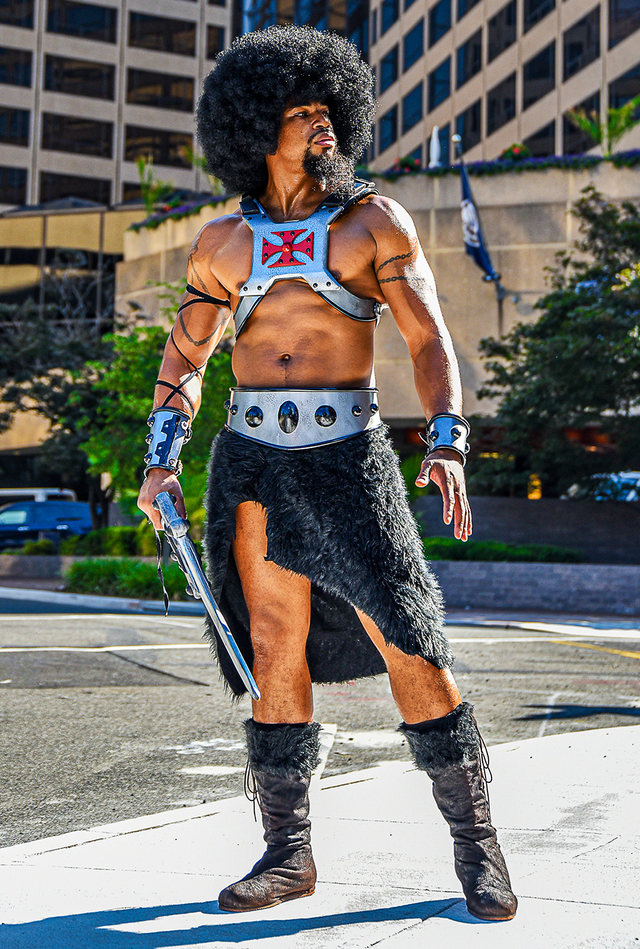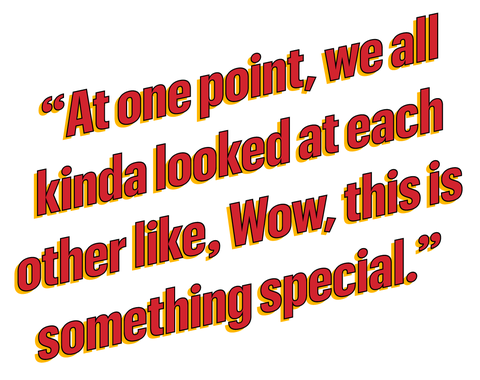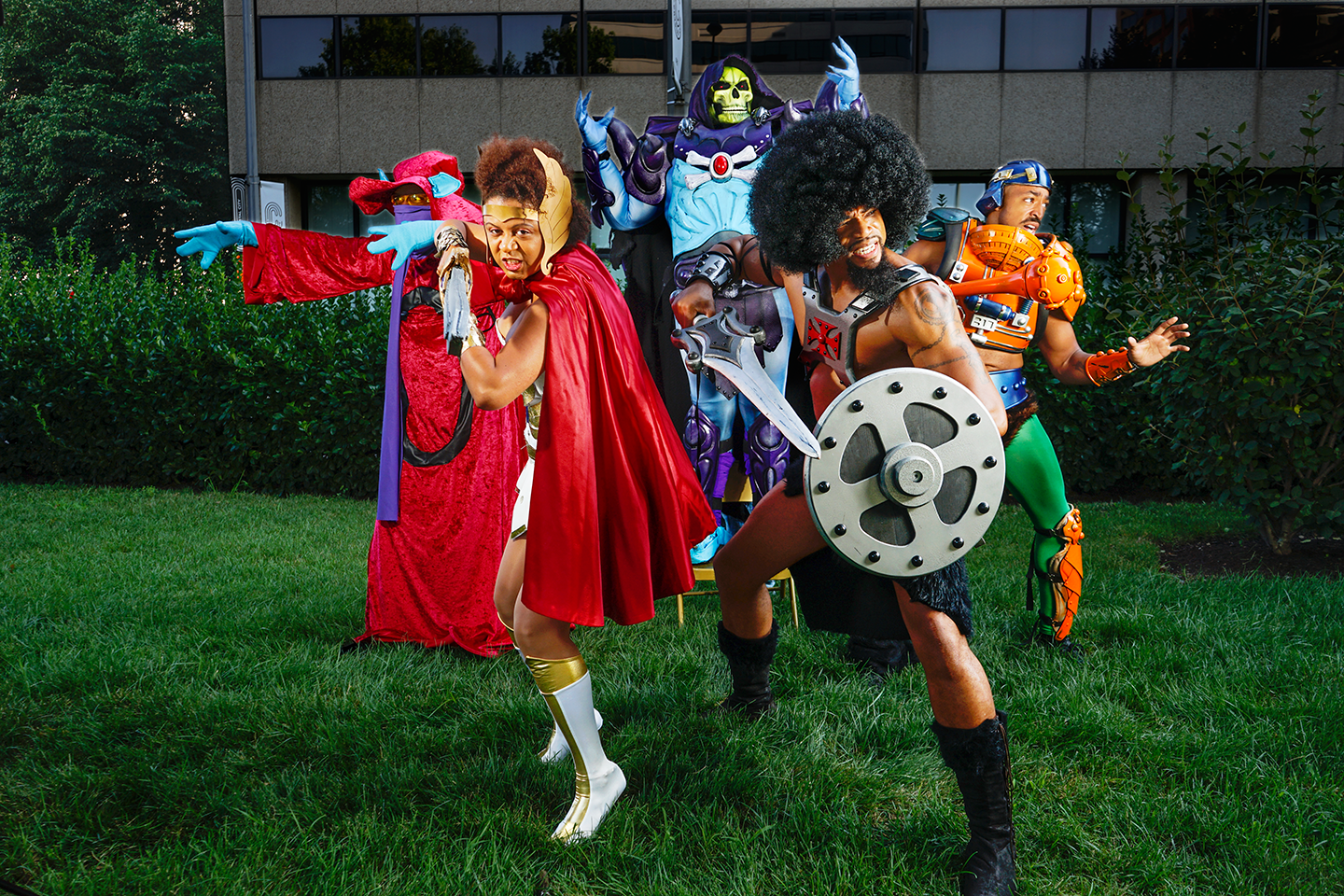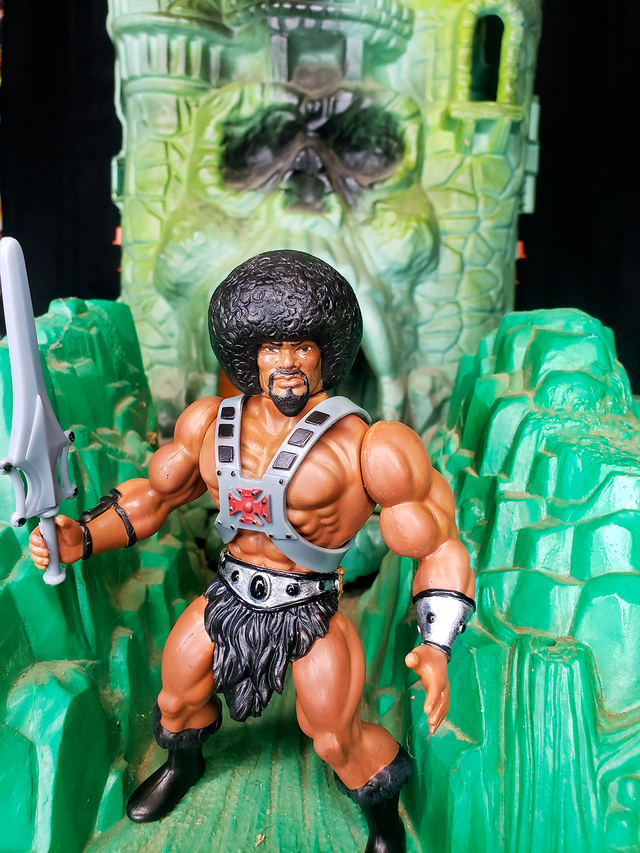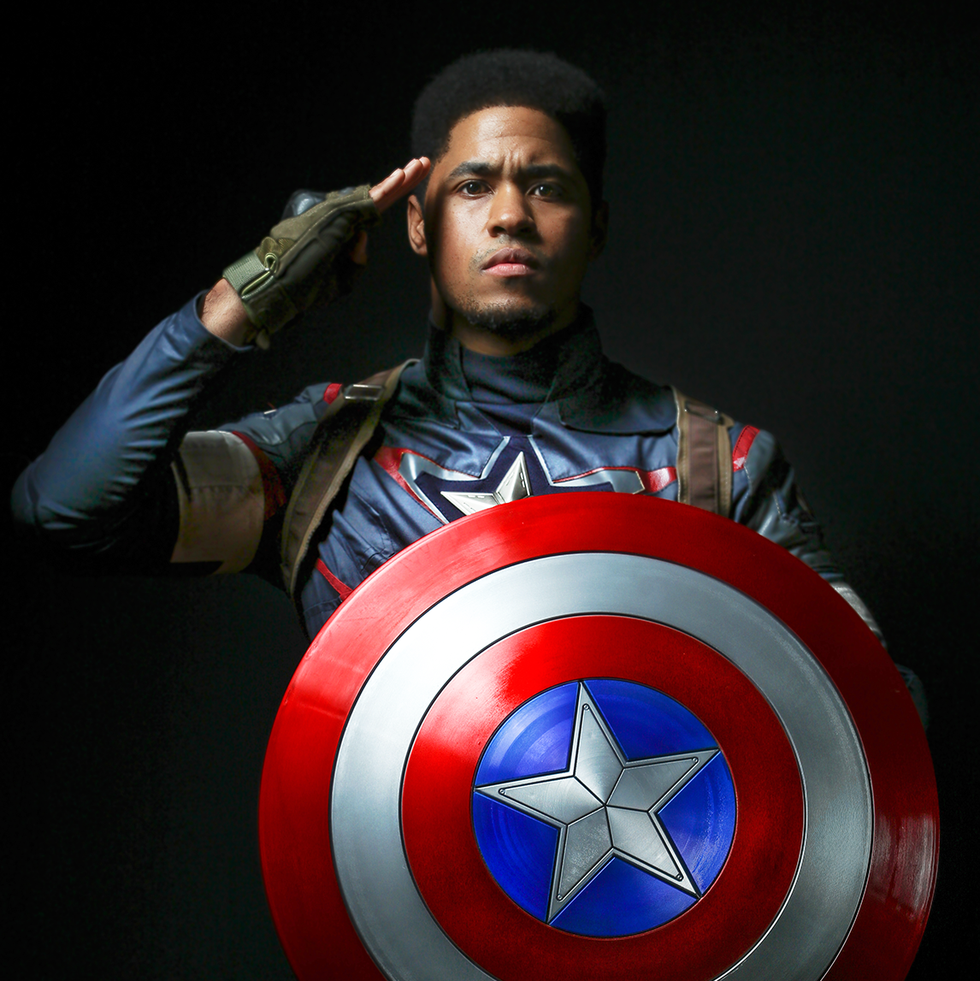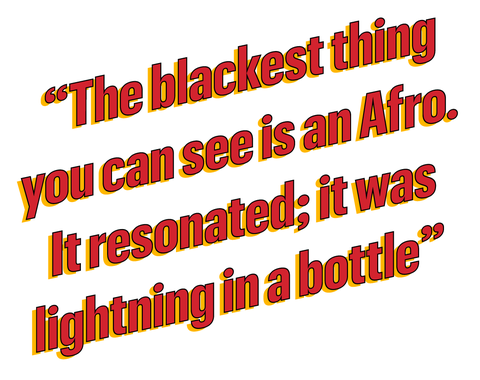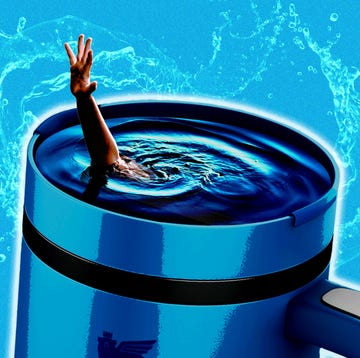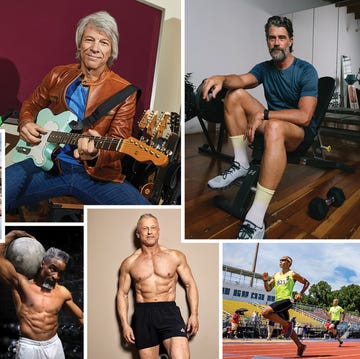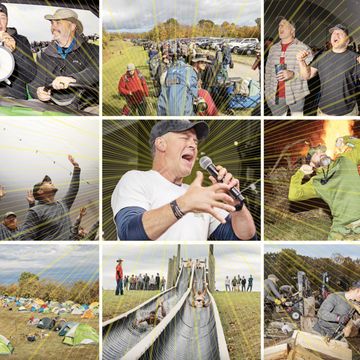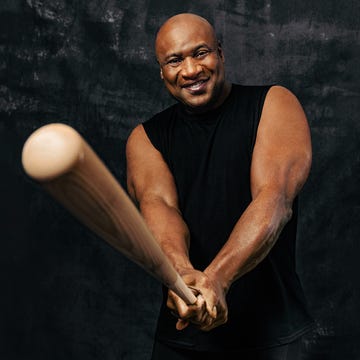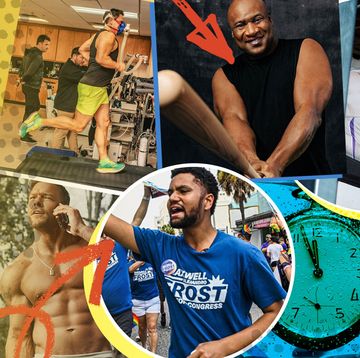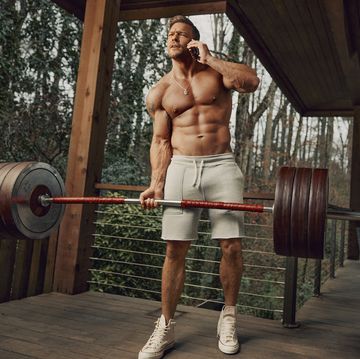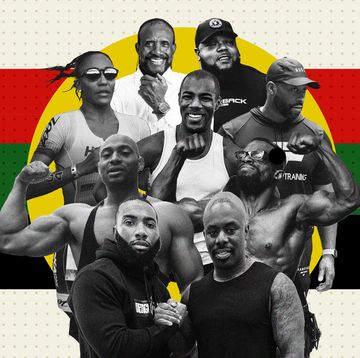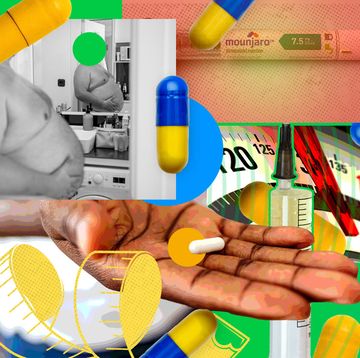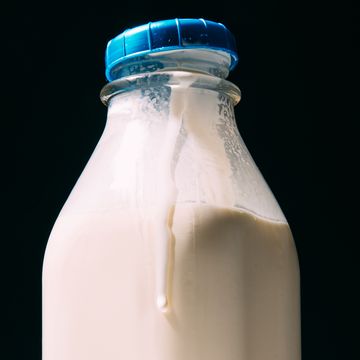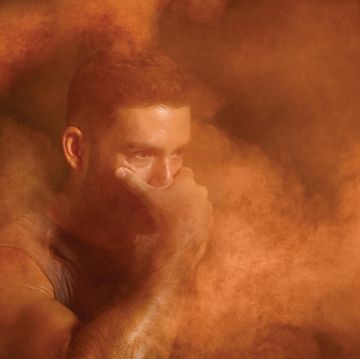AS ANYONE FAMILIAR with the legend of the world’s most jacked (and least clothed) cartoon character knows, He-Man’s go-to move is thrusting his broadsword in the air and transforming from the mild-mannered Prince Adam into a ripped dude in a loincloth.
But when a fan-made He-Man tribute video hit the Internet in the summer of 2019, that moment looked a bit different. In the clip, our hero is still cutting through the sky with his sword, but his signature blond bowl cut is replaced by a massive Afro. As his bulging arm reaches upward, his hair and blade catching the morning light, he looks like he’s raising a Black-power fist and harnessing the power of Grayskull in one swift motion.
This particular He-Man’s alter ego is Demetrius Holt, a 37-year-old single dad and electrician from Maryland. In the video, Holt’s joined by four friends playing other Masters of the Universe characters: Richard Sutton as Man-at-Arms, Eric “the Smoke” Moran as Skeletor, Lynne Finley as She-Ra, and Wendell Smith as Orko. Filmed at Blerdcon, a Washington, D. C.–area convention for Black nerds, or “blerds,” the video is only 60 seconds but shows exactly who has the power. Thanks to quick-cut shots of each character and a techno mix featuring audio from the cartoon, it feels like a trailer for a new Masters of the Universe live-action movie with an all-Black cast.
Holt remembers being a touch cranky at the start of the shoot. He was on a strict diet to prepare for his portrayal of He-Man, and his mind was on his next meal. It’s the sort of urge he used to endure for bodybuilding contests, before he realized he could use his physique to achieve a different kind of recognition. Once filming began and people were stopping their cars to gawk or yelling out affirmations as they walked by, he was no longer thinking about his stomach. “At one point, we all kinda looked at each other like, Wow, this is something special,” he says.
Since hitting the Internet, the montage has racked up more than a half million views, and most of the people commenting are excited. “That afro is a thing of glory,” says one. “I’m soooo glad that MY PEOPLE are getting more recognized for their cosplay skills and creativity!!! LOVE IT!!!” adds another. A third simply drops a hashtag: #Blackexcellence.
While Holt’s crew has ceased assembling during the pandemic, their impact is still reverberating. In late 2020, Holt and Sutton earned an invitation to discuss the empowering effects of cosplay (that’s geek speak for the wide world of comics and/or pop-culture role-playing) at the AfroPunk festival, a national and, this year, virtual celebration of the music and culture of the African diaspora. That’s exactly how Holt hopes his efforts will be noticed. “From my perspective, representation shows Black boys and girls that they can be more than what’s expected of them [by society],” he says.
Cosplay might sound fringy until you realize that the world’s biggest movie stars play Avengers, that “Workout gear or Marvel costume?” could be its own meme, and that the “Wakanda forever” salute has become a symbol of Black empowerment. The adults who take it to the next level by donning full costumes say the act is an undeniably joyful pursuit. In fact, plenty of emerging research shows that there might be another payoff from the symbolic association of cosplay, because people who dress up to look more powerful may carry that feeling with them into the rest of their lives.
For Black cosplayers, however, it can also be a form of cultural expression and a reminder to toy manufacturers, movie studios, and especially people dealing with systemic racism in their own lives that heroes don’t come in a single shade. “We’ve been underrepresented in media, in Hollywood, on TV, and certainly with our superheroes,” says Avalaura Gaither, L.G.S.W., a Maryland-based life coach. “We love having somebody to root for that looks like us, somebody we can relate to, somebody whose story is our story. It makes sense that we would want to take characters we love and adore—characters that represent how we see ourselves or how we want to see ourselves—and make those characters look more like us.”
Blerdcon started in 2017 and now attracts about 10,000 people annually. And thousands more cosplayers are connecting and expanding the universe through Internet groups like POC Cosplayers, founded by Jessica Green in 2009, as well as hashtags and viral movements. (See #Blackcosplayerhere, started by Belema Boyle, and #28DaysofBlackCosplay, created by Chaka Cumberbatch, which is celebrated during Black History Month.) They’ve all found their own way to improve the world while feeling vital.
This vanguard includes Tyler Hoover, aka @Tstunningspidey, a Virginia Beach break-dancer who flips and thwips as Spider-Man (Peter Parker, not Miles Morales) for more than 70,000 followers on Instagram, and Charles Nelson, an actor and fitness model in Houston who cosplays as Captain America in support of the #BlackLivesMatter movement. In Las Vegas, Hardy Woods, a limestone miner and Army veteran, embodies his own version of Cap and is part of a Marvel-universe crew that visits extremely sick kids who are hospitalized. (See “More Heroes of Their Own Stories,” slideshow below.)
Holt’s own origin story begins in the 1980s in southern Maryland. “I’ve been into comics since I was four,” he says. “My mom had a really big hand in that, and then my dad came in on the other side, with model kits and things like that—it’s all part of my DNA.” His older siblings pushed him even deeper into fandom. “My brother was into Transformers, G.I. Joe, He-Man, and he passed that down to me, while my sister was trying her best to get me to understand who LL Cool J was, and I was gravitating toward X-Men and Spider-Man. This is the stuff that’s baked into my heart and mind.”
While he definitely noticed a dearth of characters who looked like him growing up, Holt says that absence really hit him when he saw the excitement around Black Panther before the film’s early-2018 release. “We had Meteor Man, we had Blankman,” he says, referring to two comedic portrayals of Black heroes. “But we didn’t have images that meant something, that we could get behind.”
Holt says he’d been interested in cosplay since first learning that it was a thing, but he didn’t jump into it in earnest until 2017, when his three-year marriage was ending. He and his now ex-wife were competitive bodybuilders, and after one competition, Holt thought his show-ready physique resembled that of Kratos, the protagonist of the video game God of War. He had always been a “Halloween guy” with an interest in dressing up, but he finally made the leap because he liked the idea of embodying the iconic antihero, then washing off the body paint and stepping into a new, post-divorce phase of life.
He spent two months pulling together the costume, and the resulting cosplay was a hit at 2017’s Awesome Con, a massive pop-culture convention in D. C. (“These aren’t fake muscles, I don’t think?” asked one interviewer in a video clip from that day. “No, no, that’s me,” he replied.)
He stuck with cosplay in part because his first outing made such a splash. “I’m a believer in ‘Go where you’re invited,’ ” he says. He soon learned that small businesses—all those folks selling toys and stickers and T-shirts at conventions—would pay him to dress up and promote their wares at these events, which would cover the costs of what can be a pricey hobby.
He went on to try out other characters—including Icon, who is often called the Black Superman, and Khal Drogo—before deciding on his version of He-Man, the hero of his favorite ’80s-era cartoon. Even though the Black cosplay community is known for being body positive, inclusive, and welcoming to characters of all shapes and sizes, Holt’s dream of being He-Man involved realistically mirroring those cartoonish muscles.
Chasing that goal became an anchor as he discovered what it was like to live alone and share custody of his son, Kaua’i, two, who often cosplays with him. So he continued carb cycling, drinking at least a gallon of water per day, and hitting his two-and-a-half-hour workouts. But after all that rigorous training, the most important choice he made when creating the He-Man cosplay wasn’t which muscle group to work but what kind of wig to wear. “The Blackest thing you can see is an Afro,” he says. “It resonated; it was lightning in a bottle.”
Holt’s eventual Man-at-Arms, Sutton, 31, had served in the Army and was working as a personal trainer and daycare provider in Maryland when they first crossed paths. The two met briefly at a 2018 cosplay photo shoot, but their friendship started after Sutton noticed Holt’s @hellspawned_cosplay Instagram account in June 2019. Sutton had already been cosplaying for a few years, as characters like Mal from the Teen Titans and Turk from Scrubs, and he credits cosplay for helping him kick-start his own fitness routine and serving as a good release from anxiety caused by PTSD from his time in the military. “As a trainer, I was telling others to eat healthy and be healthy, but if you asked me to take my shirt off at a pool, I wasn’t comfortable,” Sutton says.
He and Holt bonded by talking trash online about each other’s fitness regimens. “I had started a diet where I cut all carbs . . . and after three months of no carbs, you get angry,” Sutton says. “I made a video and I said, ‘He-Man cosplay, I don’t know who you are, but you’re going down!’ And I tagged Demetrius.”
Soon the two were messaging each other, often publicly, and egging each other on. “He’d message me, ‘Oh, you’re sleeping? You ain’t grinding!’ I’d have to jump up, go to the gym, and respond. ‘I stay in the gym! I’m here all day!’ Our friendship was built off that animosity,” says Sutton, who eventually dropped 40 pounds.
They also realized they had a friend in common: Moran, a former pro wrestler and retired Marine who lives in Philadelphia and says cosplay helped him deal with his own PTSD-related anxiety.
Moran, 51, is a leader within the cosplay world, having played hundreds of characters over the past three-plus decades. He invited Holt, Sutton, and several other cosplayers from around the country to one of his annual “SmokeCon” meetups, which led to the creation of the full team. “I’m in a sea of people, where before I was in the sandbox by myself,” Moran says.
But even at a time when Black cosplayers are growing in number and finding it easier to discover kinship in the community, the camaraderie is special.
“It was amazing that when I dropped He-Man, Richard decided he wanted to get in shape and be Man-at-Arms, and Eric, who has been in the community for decades, decided to join in,” Holt says. “We were our own unit, and people saw that, and then we started seeing more cosplay groups pop up in the same fashion we did.”
Holt has around 12,000 Instagram followers, sells apparel bearing his likeness, and shares pictures that are circulated on Reddit and elsewhere online. One custom-toy maker sells reimagined Funko Pop figures modeled after him. Though he’s increasingly visible, he maintains that overall change isn’t coming fast enough. Holt tags Mattel and Netflix in his content so the companies can see how much attention posts featuring Black superheroes receive.
Part of the urgency: He views fighting for inclusion of Black faces in all spaces as part of his job as a dad. Cosplay has become a fun father-son hobby for the two of them. Holt loves sourcing tiny costumes and staging photo shoots with Kaua’i, but he sees it as being deeper than a good time. “If I don’t make everyone feel comfortable seeing us, I feel like I haven’t done my job to make the world safer for my son.”
Still, he had some doubts about showing up in costume at the AfroPunk event. “It’s not like I’ve been in the gym at all because of Covid,” he said beforehand. In the end, he went shirtless, just to make sure he had everyone’s attention—and talked about the need for a “proliferation” of positive Black voices and role models. He and Sutton shared the spotlight, in hopes that more people could learn from their experience.
“You start to figure out who you are, you learn these heroes, you want to be like them,” Sutton told the audience. “And you eventually learn the only hero you need to be is you.”
This story appears in the May 2021 issue of Men's Health.
